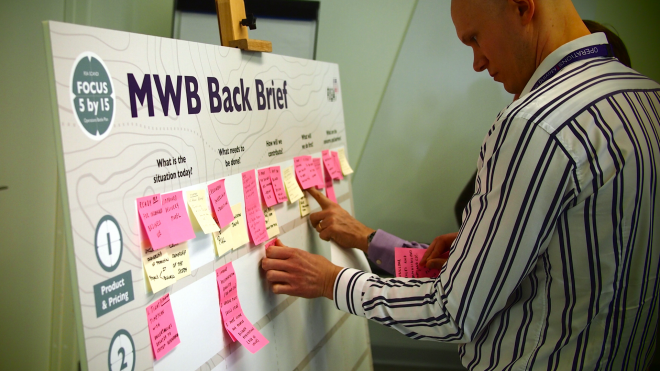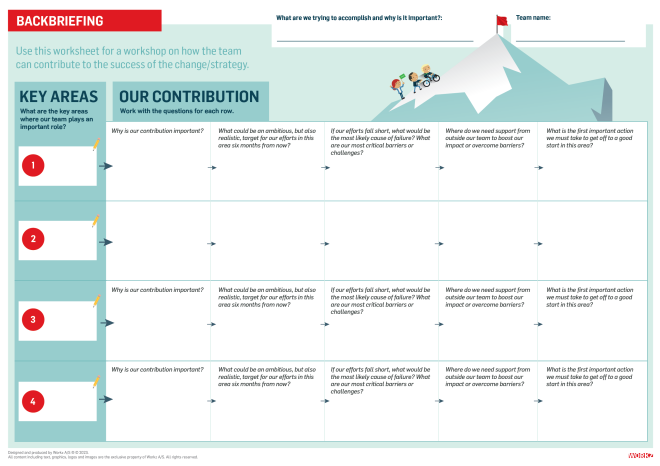Backbriefing for Empowerment
On using backbriefing to accelerate alignment and autonomy.
8 min read ·
A classic scenario: After months of analysis, endless meetings and discussing with the Board, the new strategy is finally ready for action.
Following the big kick-off event and roll-out of a grand internal communication campaign, everybody looks forward to seeing the implementation in motion. But not much happens.
A few dedicated teams are able to show progress, but the majority of the organisation continues as before because daily operations cannot be ignored and even though everybody liked the strategy, it quickly fades from memory.
Does this sound familiar? Lack of momentum in strategy implementation can have many causes. From organisational resistance to change over cultural challenges to unclear mandates. Some of these problems can be difficult to fix while others are more manageable.
This article teaches you how to deal with a special set of obstacles that often come together – we call them small sins of strategic disempowerment:
Sin #1; Expecting people to understand the strategy just by hearing it
We tend to be overly optimistic about people’s ability to comprehend and remember complex messages. We assume that if we deliver a well-rehearsed presentation supported by a thick slide deck, and perhaps a flashy film, the whole organisation will get a lasting sense of direction and purpose.
The inconvenient truth is that we all have a hard time remembering information presented to us as one-way communication.
Sin #2; Assuming that people can prioritise multiple initiatives and objectives
Most strategies are comprised of a multitude of must-win-battles, strategic objectives and critical success factors. We expect our colleagues to be able to navigate this complexity, and to be able to prioritise between them, without further help.
The problem is that everybody has their own set of existing issues and priorities that is added to the ones presented in the new strategy. Only rarely are colleagues able to align their own priorities with that of the strategy, and even the most comprehensive strategy cannot account for every individual.
When in doubt, we stick to the priorities of the past and we all tend to allow minor, but urgent, affairs to trump issues that are important in the long term.
Sin #3; Expecting people to know how they can contribute to the strategy
Because strategy is a shared responsibility, we expect our colleagues to take action as soon as we have presented them with the new direction. This is either overly optimistic or down right naïve.
Most strategies are abstract and vague, and only rarely are expectations, responsibilities and mandates clearly defined. Some colleagues have the drive to show initiative and navigate the muddy waters, but many fall back to a passive wait-and-see position.
In my 20+ years as a consultant, I have experienced these sins again and again across different industries and countries. They seem to be as recurring as the common cold.
The good news is that these three challenges can all be addressed by the same remedy, a method known as back-briefing. It is not a sure-fire fix, but it is a very actionable and flexible approach where even a limited effort can make a difference.

Briefing back
The methodology of backbriefing is rooted in military tradition and is used by emergency and military services worldwide. Refined by the Prussian military in their “Auftragstaktik” doctrine, backbriefing is used to ensure that local units can take autonomous action, while still being loyal to the shared strategy.
In a nut-sell, backbriefing has four parts:
- The brief: First step is for the “commander” to present the “strategic intent” – the why and what of the strategy. This brief should be as simple as possible with limited room for interpretation or misunderstanding. In the wise words of The Spice Girls – “Tell me what you want, what you, really, really want!” A one-page letter or a 7-minute talk should be sufficient to explain the overall direction.
- Translation: After receiving the brief, the team respond by discussing what they’re heard and how it translate to their function and areas of responsibility – what can they do to contribute? The translation step can be from one hour to a full day workshop depending on the complexity of the strategy and situation.
- Briefing back: After working with the brief, the team meets again with their “commander” and repeat the why and what of the “strategic intent” in their own words. In addition, the team adds their own how by briefing back on which specific actions they will begin taking. They also add their concerns and what kind of help they will need to deliver successfully.
- Feedback and alignment: After the brief and backbrief, it is time for the “commander” to provide feedback. It can be to ensure alignment about a critical part of the strategic intent, to create clarity about key priorities or to acknowledge and encourage planned actions. In this part of the process, it is vital that the “commander” refrain from any inclinations to micro-manage. The purpose is to support empowerment and shared alignment, not to convey a long list of specific instructions.
Normally, the process of backbriefing is translated down the chain-of-command – from top management to their direct reports, and then further down to the different departments and teams. It is also recommended that teams conduct horisontal alignment and feedback with other teams where there might be interdependences or synergies.
When done right, the four steps of backbriefing can help mitigating the small sins of strategic disempowerment we addressed earlier. Clarifying the essence of the strategy as a short statement of “strategic intent” and overall direction makes it easier to understand, and repeating the brief in one’s own words boosts memory and retention. The process helps create alignment on expectations, top priorities and objectives. in addition, it provides the team with clear responsibility and mandate.
Backbriefing as designed dialogues
So, how to go from century-old Prussian military doctrine to modern corporations? Despite the many differences between corporate operations of today and European warfare in the 1800-hundreds, backbriefing has shown itself across multiple industries to be a helpful and flexible concept that works great with both top-management teams and broader organisational involvement.
At Workz, we see backbriefing as a designed conversation that supports sense-making and shared understanding between a leader and her or his reports. We like to use visual dialogue tools to support the desired process – in many cases, we design large visual “work boards” that are used at leadership summits or workshops.
After getting a presentation of the direction of the company in plenary, the participants are split into small functional teams. Each team is provided with a work board that guides their work – from recapping the why and what of the mission, and discussing how the team can contribute best, to pinpointing key challenges that must be mitigated.
After working 1-3 hours with their work boards, it is pitching time. Here, the teams take turns presenting the essence of their work to the other teams and their manager, who then provides feedback and comments.
It is possible to use the principles of backbriefing in digital communication, but we highly recommend doing the process face-to-face. It is much easier to create a shared language and fixing misunderstandings when we have the important dialogue in real life. Meeting face-to-face can also be a great way of improving team-sprit and mutual trust.
An efficient backbriefing workshop needs guidance and a well-structured work boards, but it is our experience that the process is very easy to facilitate and that all kinds of participants appreciate being involved.
That being said, there are two potential mistakes that are important to remember: Do not try to rush the dialogues by allocating too little time for the workshops, and make sure that the managers contain their inclinations to micro-manage when they provide feedback after hearing the back-brief. Valuable dialogues take time and mutual respect.

Engaging through backbriefing
Integrating a backbriefing workshop as part of a leadership summit or strategy kick-off is highly recommended, but the concept can also be used as a cascading way of engaging the whole organisation.
For many of our clients, we have designed different “workshop-in-a-box” solutions that helps each leader run a 2-3 hour backbriefing session with her or his team. These solutions are often comprised of three elements:
- A poster with a compelling visualisation of the strategy/mission (a so-called One Pager) to support the briefing of the strategic intent.
- A work sheet that guides the work of the participants. You can download a generic version from the box in the sidebar, but we often design one specifically for the situation and client.
- A follow-up board for prioritising specific tasks and mapping of their progress.
A platform for leadership
Many managers experience a gap between the leader they would like to be and the way that they end up prioritising their time. We would like to develop, motivate and inspire our employees through coaching, involvement, acknowledgement and constructive feedback. However, we often end up filling our weekly calendar with managerial tasks, back-to-back meetings and answering tsunamis of emails.
Done well, the process of backbriefing can provide an outstanding platform for managers to lead with excellence – from creating clarity, purpose and drive to boost ownership, commitment and accountability. Backbriefing is not an easy fix for managers who are too busy to lead, it is an investment in building a better leadership culture.